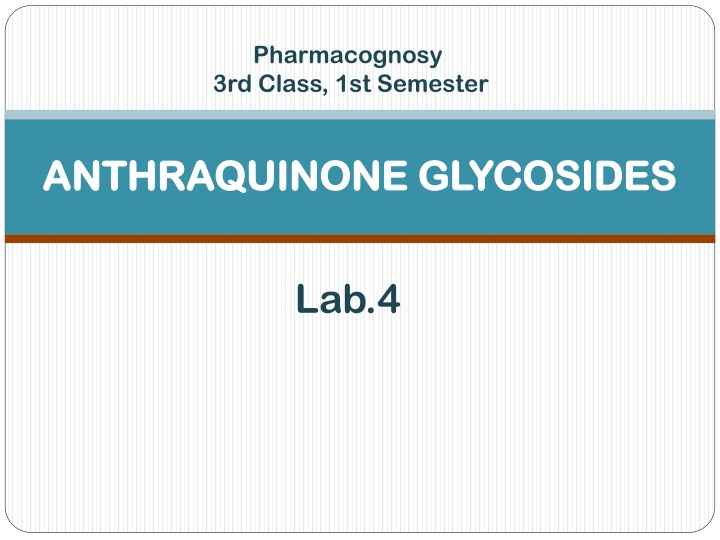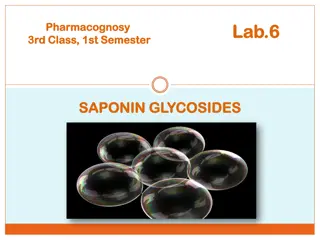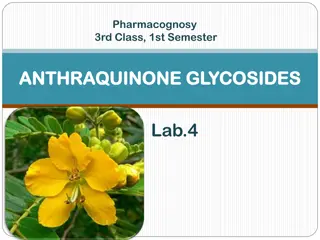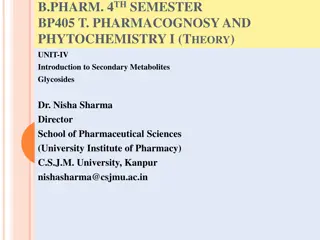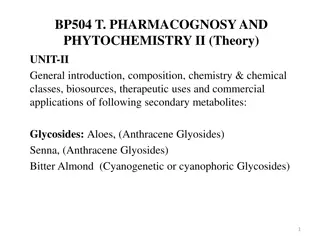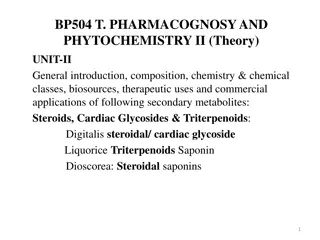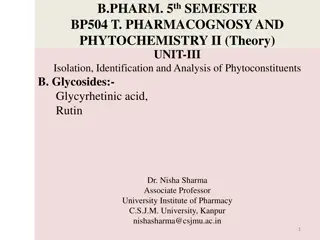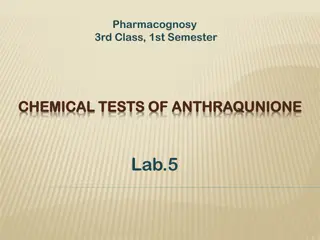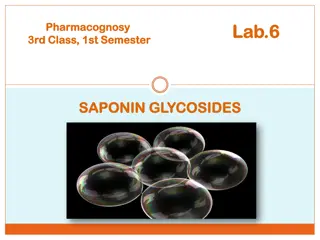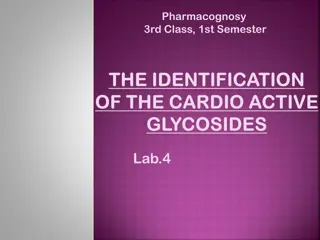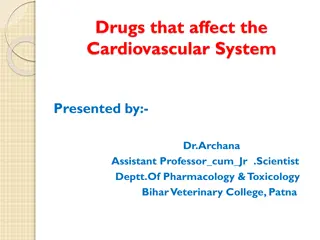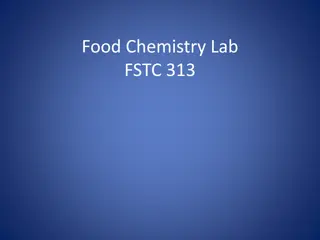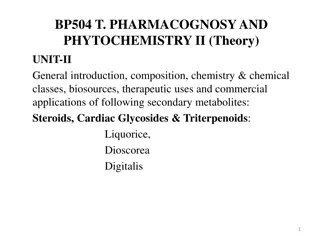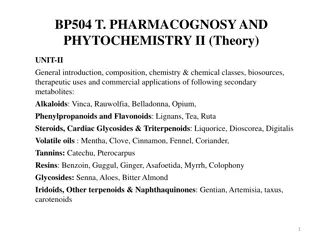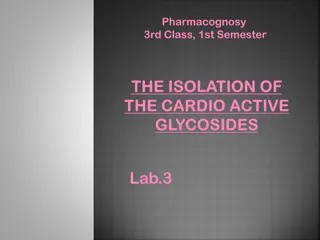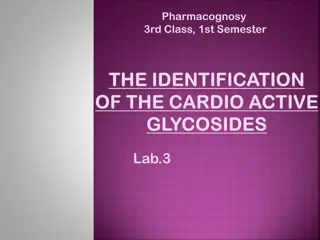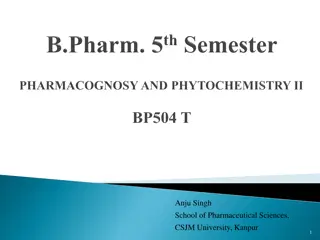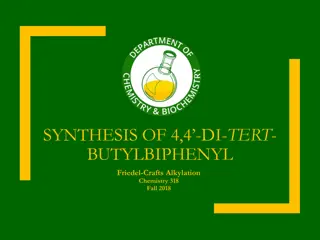ANTHRAQUINONE GLYCOSIDES Lab.4
Anthraquinone glycosides, found in certain plants, exert a stimulant cathartic effect by increasing smooth muscle tone in the colon. Administered orally, these compounds are hydrolyzed in the colon to active forms, providing relief from constipation. Long-term use of stimulant laxatives can lead to dependence, making it advisable to consume high-fiber foods and hydrate well. The extraction process of anthraquinone glycosides, particularly from Senna plant, involves various steps like boiling the powdered drug, centrifuging, and extracting using chloroform.
Download Presentation

Please find below an Image/Link to download the presentation.
The content on the website is provided AS IS for your information and personal use only. It may not be sold, licensed, or shared on other websites without obtaining consent from the author.If you encounter any issues during the download, it is possible that the publisher has removed the file from their server.
You are allowed to download the files provided on this website for personal or commercial use, subject to the condition that they are used lawfully. All files are the property of their respective owners.
The content on the website is provided AS IS for your information and personal use only. It may not be sold, licensed, or shared on other websites without obtaining consent from the author.
E N D
Presentation Transcript
Pharmacognosy 3rd Class, 1st Semester ANTHRAQUINONE GLYCOSIDES ANTHRAQUINONE GLYCOSIDES Lab.4
Introduction Anthraquinone and related glycosides are organic compounds found in some plants and have a stimulant cathartics effect which exert their action by increasing the tone of the smooth muscle in the wall of the colon and stimulate the secretion of the water and electrolytes into the large intestine. After the oral administration, the Anthraquinone glycosides are hydrolyzed in the colon by the action of enzymes of the micro flora, to the pharmacologically active free aglycone which usually produce their effect in 8-12 hour after administration, these agents are indicated for constipation in patient who do not respond to milder drugs and for bowel evacuation before investigation procedures or surgery.
Stimulant laxative are habit forming so the long term use may result in laxative dependence and loss of the normal bowel function and become lazy so for this reason its better just to eat foods with lots of fiber and drink water, fresh juices that will cleanse system. The glycoside of anthranols and anthrones which is reduced anthraquinone derivatives elicit a more drastic reaction than do other anthraquinone, and cause discomfort and gripping action. The drugs mostly used are, cascara, frangula, casanthranol and senna. The aloe and rhubarb are not recommended due to their irritating action, which increase the chance for gripping effect. The Anthraquinone hydrolyzed to give aglycone, which are Di, Tri or Tetra- hydroxyanthraquinone. Also there are anthrone,dianthrone and oxanthrone.
Extraction OF Anthraquinone glycosides (Senna) Place 0.5 gm of powdered drug in a beaker Add 50 ml of water Boil gently for 15 minutes, cool and centrifuge or can use filter Place the filtrate in separatory funnel and extract by shaking with two quantities of (2*30 ml) chloroform Obtain two layers (Aqueous & Organic )
Fraction B Organic Layer concentrate to about 1ml Aqueous Layer 1) 2) 3) 4) The other part is place in a 250 ml round bottom flask Adding to it 3.5 of ferric chloride solution (60%w/v). Reflux for 20 minutes Add 2ml of concentrated HCL acid , continue heating for further 20 minutes , shaking the flask occasionally to dissolve as possible of the precipitate, and allow cooling. Place the hydrolysate in a separatory funnel and extract with two quantities of (2*30ml) chloroform Placed in small flask and evaporate carefully almost to dryness on a rotary evaporator 5) Fraction A Fraction C Concentrate the bulked chloroform extracts to about 3ml
Discussion Discussion The chloroform layer will contain the free aglycone (fraction B) , while the aqueous layer will contain the glycoside as a whole , since sugar is water soluble (fraction A) . The use of ferric chloride and HCL and reflux is to break the C-C bond in the dimmer, which is very strong bond so need strong conditions.
Identification by chromatography by the use of T.L.C technique The stationary phase = silica gel G The mobile phase = n-propanol : ethyl acetate: water (40: 40:30) Spray reagent =alcoholic KOH (5%w/v) (For better result spray first with 25 %( w/v) nitric acid then heat in the oven, after that spray with KOH reagent. This step is done to intensity the color of the spots.)
Procedure Procedure Prepare the solvent system and place it in the glass tank, leave it for 45minutes before use. Apply the sample fraction A, B, C, each sample with standard on the separated plate. Place the three plate in the tank and allow the mobile phase to rise to about two third the plates then after drying at room temperature, spray first with 25%nitric acid solution and heat for 10 minutes at 110 c . Allow to cool, and then spray with 5% w/v alcoholic KOH solution. Detect the spots formed and calculate the Rf value.
